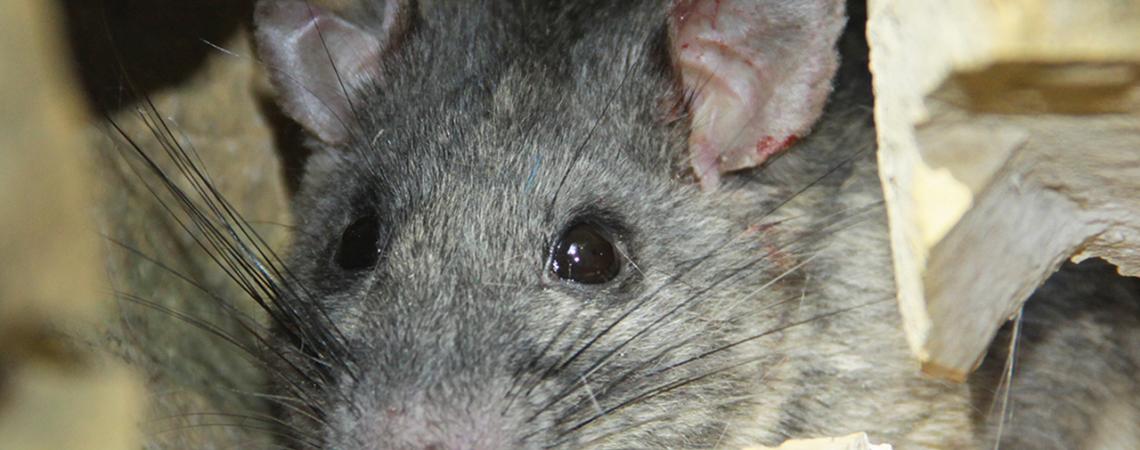The Allegheny woodrat (Photo by Chip Gross)
Not many people get excited upon seeing a rat, at least, not in a positive way. But there is a group of folks in southern Ohio who go absolutely giddy when spotting one. They are wildlife researchers, and the object of their ardor is the Allegheny woodrat, a state-endangered species.
I had the opportunity to tag along with this group of dedicated wildlife biologists on a perfect early-fall day. The prior evening, they had set more than 50 live traps in a steep, heavily wooded valley in the sprawling Edge of Appalachia preserve in Adams County, near the Ohio River.
Approaching the first few traps, Laura Stalder, one of the researchers, yelled, “We got one!”
The animal was a large male, weighing about three-quarters of a pound. After the weighing, the researchers took a tiny DNA sample from the woodrat’s ear, then marked a small spot on its white belly with a blue marker before releasing it. If the woodrat is trapped again the following night — as often happens — that blue mark alerts researchers that the particular animal is a recapture.
“In just two nights, we can usually catch about 90 percent of a woodrat population living in a particular area,” says Cheryl Mollohan, the researcher heading the team.
To be clear, Allegheny woodrats are not Norway rats. Although the two species are similar in size, woodrats are indigenous to eastern North American forests. Norway rats, on the other hand, were unintentionally introduced to America centuries ago, coming ashore after stowing away in the cargo holds of sailing ships.
Woodrats are members of the packrat family, and as such, have a curious habit of building “middens.”
“A midden is not their nest, but rather, a pile of sticks, leaves, and other natural materials that woodrats gather,” says Mollohan. “The pile can be small, only the size of a dinner plate, or huge, measuring several yards long and possibly a yard deep. As researchers, if we find fresh middens, we know woodrats are in the area.”
Woodrats also have the interesting habit of collecting oddities they find in the woods, adding them to their midden. They’re attracted to shiny or unusual objects, and the day I accompanied the researchers, we found a piece of tinfoil, a penny, and a colorful bird feather in the middens we examined. Laura Stalder says that she once had a woodrat take one of the nylon straps from her trail camera to add to its midden, while a second camera recorded a video clip of the theft.
“Woodrats will also trade you for an object,” says Mollohan. “For instance, when camping in woodrat country, you might wake up one morning to find that the small pocketknife you inadvertently left outside your tent is missing, having been replaced by a nut or other natural object. If that happens, you’ve been visited during the night by a woodrat.”
Allegheny woodrats inhabit the shallow rock caves, cracks, and fissures found in large sandstone and limestone outcroppings. Mollohan believes, however, that it’s not a lack of habitat that has pushed Ohio’s woodrats onto the state-endangered list.
“Raccoon populations in the state have been extremely high for years,” she says, “and raccoons carry a parasitic roundworm that is fatal to woodrats. Woodrats will take dried raccoon feces back to their dens and search through the poop, looking for undigested seeds to eat. By doing so, they ingest roundworm eggs. Ingesting even one roundworm egg can be lethal to a woodrat. Since the eggs persist for several years in the environment, when the next woodrat moves in, it is also infected and dies.”
The Ohio DNR, Division of Wildlife, has taken the roundworm threat so seriously that not only is it funding this woodrat study, it has also been dropping de-wormer from aircraft into areas of known woodrat populations. The hope is that the de-worming of raccoons in woodrat habitats will prevent further spread of the roundworm and reduce infection.
So why should we care? What difference does it make if an obscure wildlife species, such as the Allegheny woodrat, becomes extirpated from Ohio? There are many arguments for attempting to save endangered species, but the one that rings truest for me is that the healthiest natural environments are those that support the greatest diversity of species — including humans.
If you have a wildlife or outdoors-related story idea you’d
like our outdoors editor to investigate, he can be reached
by email at whchipgross@gmail.com.









